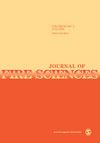Re-examination of the intumescence mechanism of ammonium polyphosphate/pentaerythritol/zeolite 4A fire-retarded formulation using advanced spectroscopic techniques
IF 1.9
4区 工程技术
Q2 ENGINEERING, MULTIDISCIPLINARY
引用次数: 0
Abstract
The mixture of ammonium polyphosphate and pentaerythritol is a very efficient intumescent system suitable for polyolefins, especially polypropylene. In this article, the intumescence mechanism of this intumescent system with and without zeolite 4A used as a synergy agent is revisited. The intumescent system was investigated in depth using continuous-wave electron paramagnetic resonance spectroscopy, solid-state nuclear magnetic resonance, and the advanced technique, namely hyperfine sublevel correlation pulsed electron paramagnetic resonance. It was observed that the char generated between 250°C and 350°C is made of polycyclic heterocyclic radicals with nitrogen atoms and that free radicals are mainly generated at these temperatures with a spin concentration relatively stable at least up to 500°C. Moreover, the presence of hydrogen, carbon, nitrogen, and phosphorus was clearly evidenced in the chemical environment of free electrons at 350°C (hyperfine sublevel correlation pulsed electron paramagnetic resonance). Besides, it was also evidenced that 4A totally collapses below 250°C. Contrary to previous works suggesting the presence of aluminosilicophosphate complexes, this work demonstrated that distinct alumino- and silicophosphate complexes are generated and protected the residue at high temperatures.利用先进的光谱技术重新研究聚磷酸铵/季戊四醇/沸石 4A 阻燃配方的膨胀机理
聚磷酸铵和季戊四醇的混合物是一种非常高效的膨胀体系,适用于聚烯烃,尤其是聚丙烯。本文重新探讨了这种膨胀体系的膨胀机理,包括使用沸石 4A 作为增效剂和不使用沸石 4A 作为增效剂。采用连续波电子顺磁共振波谱、固态核磁共振以及先进的超细子级相关脉冲电子顺磁共振技术对该膨胀体系进行了深入研究。研究发现,在 250°C 至 350°C 之间产生的炭是由含氮原子的多环杂环自由基组成的,自由基主要在这些温度下产生,其自旋浓度至少在 500°C 之前相对稳定。此外,350°C 时自由电子的化学环境中明显存在氢、碳、氮和磷(超细子级相关脉冲电子顺磁共振)。此外,还证明 4A 在 250°C 以下完全塌缩。与之前认为存在铝硅磷酸盐复合物的研究相反,这项研究表明,在高温下会产生不同的铝磷酸盐和硅磷酸盐复合物,并保护残留物。
本文章由计算机程序翻译,如有差异,请以英文原文为准。
求助全文
约1分钟内获得全文
求助全文
来源期刊

Journal of Fire Sciences
工程技术-材料科学:综合
CiteScore
4.00
自引率
0.00%
发文量
14
审稿时长
2.5 months
期刊介绍:
The Journal of Fire Sciences is a leading journal for the reporting of significant fundamental and applied research that brings understanding of fire chemistry and fire physics to fire safety. Its content is aimed toward the prevention and mitigation of the adverse effects of fires involving combustible materials, as well as development of new tools to better address fire safety needs. The Journal of Fire Sciences covers experimental or theoretical studies of fire initiation and growth, flame retardant chemistry, fire physics relative to material behavior, fire containment, fire threat to people and the environment and fire safety engineering. This journal is a member of the Committee on Publication Ethics (COPE).
 求助内容:
求助内容: 应助结果提醒方式:
应助结果提醒方式:


